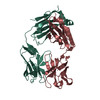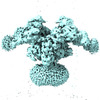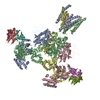[English] 日本語
 Yorodumi
Yorodumi- EMDB-25852: Cryo-EM structure of GluN1b-2B NMDAR in complex with Fab5 in non-... -
+ Open data
Open data
- Basic information
Basic information
| Entry | Database: EMDB / ID: EMD-25852 | |||||||||
|---|---|---|---|---|---|---|---|---|---|---|
| Title | Cryo-EM structure of GluN1b-2B NMDAR in complex with Fab5 in non-active2-like conformation | |||||||||
 Map data Map data | ||||||||||
 Sample Sample |
| |||||||||
| Function / homology |  Function and homology information Function and homology informationneurotransmitter receptor activity involved in regulation of postsynaptic membrane potential / cellular response to curcumin / cellular response to corticosterone stimulus / cellular response to magnesium starvation / NMDA selective glutamate receptor signaling pathway / regulation of postsynaptic cytosolic calcium ion concentration / sensory organ development /  sensitization / pons maturation / sensitization / pons maturation /  regulation of cell communication ...neurotransmitter receptor activity involved in regulation of postsynaptic membrane potential / cellular response to curcumin / cellular response to corticosterone stimulus / cellular response to magnesium starvation / NMDA selective glutamate receptor signaling pathway / regulation of postsynaptic cytosolic calcium ion concentration / sensory organ development / regulation of cell communication ...neurotransmitter receptor activity involved in regulation of postsynaptic membrane potential / cellular response to curcumin / cellular response to corticosterone stimulus / cellular response to magnesium starvation / NMDA selective glutamate receptor signaling pathway / regulation of postsynaptic cytosolic calcium ion concentration / sensory organ development /  sensitization / pons maturation / sensitization / pons maturation /  regulation of cell communication / positive regulation of Schwann cell migration / EPHB-mediated forward signaling / neurotransmitter receptor activity involved in regulation of postsynaptic cytosolic calcium ion concentration / Assembly and cell surface presentation of NMDA receptors / olfactory learning / regulation of protein kinase A signaling / regulation of cell communication / positive regulation of Schwann cell migration / EPHB-mediated forward signaling / neurotransmitter receptor activity involved in regulation of postsynaptic cytosolic calcium ion concentration / Assembly and cell surface presentation of NMDA receptors / olfactory learning / regulation of protein kinase A signaling /  conditioned taste aversion / protein localization to postsynaptic membrane / conditioned taste aversion / protein localization to postsynaptic membrane /  dendritic branch / regulation of respiratory gaseous exchange / propylene metabolic process / response to glycine / dendritic branch / regulation of respiratory gaseous exchange / propylene metabolic process / response to glycine /  apical dendrite / response to other organism / fear response / response to methylmercury / voltage-gated monoatomic cation channel activity / positive regulation of cysteine-type endopeptidase activity / response to morphine / glutamate-gated calcium ion channel activity / cellular response to dsRNA / response to carbohydrate / regulation of monoatomic cation transmembrane transport / negative regulation of dendritic spine maintenance / apical dendrite / response to other organism / fear response / response to methylmercury / voltage-gated monoatomic cation channel activity / positive regulation of cysteine-type endopeptidase activity / response to morphine / glutamate-gated calcium ion channel activity / cellular response to dsRNA / response to carbohydrate / regulation of monoatomic cation transmembrane transport / negative regulation of dendritic spine maintenance /  interleukin-1 receptor binding / cellular response to lipid / positive regulation of glutamate secretion / interleukin-1 receptor binding / cellular response to lipid / positive regulation of glutamate secretion /  NMDA glutamate receptor activity / response to growth hormone / NMDA selective glutamate receptor complex / RAF/MAP kinase cascade / Synaptic adhesion-like molecules / parallel fiber to Purkinje cell synapse / calcium ion transmembrane import into cytosol / response to manganese ion / protein heterotetramerization / NMDA glutamate receptor activity / response to growth hormone / NMDA selective glutamate receptor complex / RAF/MAP kinase cascade / Synaptic adhesion-like molecules / parallel fiber to Purkinje cell synapse / calcium ion transmembrane import into cytosol / response to manganese ion / protein heterotetramerization /  glutamate binding / positive regulation of reactive oxygen species biosynthetic process / neuromuscular process / glutamate binding / positive regulation of reactive oxygen species biosynthetic process / neuromuscular process /  regulation of synapse assembly / regulation of synapse assembly /  action potential / action potential /  glycine binding / positive regulation of calcium ion transport into cytosol / male mating behavior / regulation of dendrite morphogenesis / glycine binding / positive regulation of calcium ion transport into cytosol / male mating behavior / regulation of dendrite morphogenesis /  regulation of axonogenesis / regulation of axonogenesis /  heterocyclic compound binding / receptor clustering / suckling behavior / heterocyclic compound binding / receptor clustering / suckling behavior /  startle response / behavioral response to pain / regulation of neuronal synaptic plasticity / response to amine / monoatomic cation transmembrane transport / startle response / behavioral response to pain / regulation of neuronal synaptic plasticity / response to amine / monoatomic cation transmembrane transport /  regulation of MAPK cascade / regulation of MAPK cascade /  social behavior / social behavior /  small molecule binding / small molecule binding /  associative learning / response to magnesium ion / positive regulation of excitatory postsynaptic potential / monoatomic cation transport / ligand-gated monoatomic ion channel activity / associative learning / response to magnesium ion / positive regulation of excitatory postsynaptic potential / monoatomic cation transport / ligand-gated monoatomic ion channel activity /  excitatory synapse / extracellularly glutamate-gated ion channel activity / cellular response to organic cyclic compound / Unblocking of NMDA receptors, glutamate binding and activation / neuron development / positive regulation of dendritic spine maintenance / excitatory synapse / extracellularly glutamate-gated ion channel activity / cellular response to organic cyclic compound / Unblocking of NMDA receptors, glutamate binding and activation / neuron development / positive regulation of dendritic spine maintenance /  glutamate receptor binding / regulation of postsynaptic membrane potential / behavioral fear response / multicellular organismal response to stress / glutamate receptor binding / regulation of postsynaptic membrane potential / behavioral fear response / multicellular organismal response to stress /  phosphatase binding / calcium ion homeostasis / D2 dopamine receptor binding / cellular response to manganese ion / phosphatase binding / calcium ion homeostasis / D2 dopamine receptor binding / cellular response to manganese ion /  prepulse inhibition / prepulse inhibition /  long-term memory / detection of mechanical stimulus involved in sensory perception of pain / positive regulation of synaptic transmission / regulation of neuron apoptotic process / response to electrical stimulus / response to mechanical stimulus / glutamate-gated receptor activity / long-term memory / detection of mechanical stimulus involved in sensory perception of pain / positive regulation of synaptic transmission / regulation of neuron apoptotic process / response to electrical stimulus / response to mechanical stimulus / glutamate-gated receptor activity /  synaptic cleft / presynaptic active zone membrane / response to fungicide / cellular response to forskolin / monoatomic cation channel activity / sensory perception of pain synaptic cleft / presynaptic active zone membrane / response to fungicide / cellular response to forskolin / monoatomic cation channel activity / sensory perception of painSimilarity search - Function | |||||||||
| Biological species |   Rattus norvegicus (Norway rat) / Rattus norvegicus (Norway rat) /   Mouse (mice) Mouse (mice) | |||||||||
| Method |  single particle reconstruction / single particle reconstruction /  cryo EM / Resolution: 4.45 Å cryo EM / Resolution: 4.45 Å | |||||||||
 Authors Authors | Tajima N / Furukawa H | |||||||||
| Funding support |  United States, 2 items United States, 2 items
| |||||||||
 Citation Citation |  Journal: Nat Commun / Year: 2022 Journal: Nat Commun / Year: 2022Title: Development and characterization of functional antibodies targeting NMDA receptors. Authors: Nami Tajima / Noriko Simorowski / Remy A Yovanno / Michael C Regan / Kevin Michalski / Ricardo Gómez / Albert Y Lau / Hiro Furukawa /  Abstract: N-methyl-D-aspartate receptors (NMDARs) are critically involved in basic brain functions and neurodegeneration as well as tumor invasiveness. Targeting specific subtypes of NMDARs with distinct ...N-methyl-D-aspartate receptors (NMDARs) are critically involved in basic brain functions and neurodegeneration as well as tumor invasiveness. Targeting specific subtypes of NMDARs with distinct activities has been considered an effective therapeutic strategy for neurological disorders and diseases. However, complete elimination of off-target effects of small chemical compounds has been challenging and thus, there is a need to explore alternative strategies for targeting NMDAR subtypes. Here we report identification of a functional antibody that specifically targets the GluN1-GluN2B NMDAR subtype and allosterically down-regulates ion channel activity as assessed by electrophysiology. Through biochemical analysis, x-ray crystallography, single-particle electron cryomicroscopy, and molecular dynamics simulations, we show that this inhibitory antibody recognizes the amino terminal domain of the GluN2B subunit and increases the population of the non-active conformational state. The current study demonstrates that antibodies may serve as specific reagents to regulate NMDAR functions for basic research and therapeutic objectives. | |||||||||
| History |
|
- Structure visualization
Structure visualization
| Movie |
 Movie viewer Movie viewer |
|---|---|
| Structure viewer | EM map:  SurfView SurfView Molmil Molmil Jmol/JSmol Jmol/JSmol |
| Supplemental images |
- Downloads & links
Downloads & links
-EMDB archive
| Map data |  emd_25852.map.gz emd_25852.map.gz | 59.2 MB |  EMDB map data format EMDB map data format | |
|---|---|---|---|---|
| Header (meta data) |  emd-25852-v30.xml emd-25852-v30.xml emd-25852.xml emd-25852.xml | 20.5 KB 20.5 KB | Display Display |  EMDB header EMDB header |
| Images |  emd_25852.png emd_25852.png | 54.6 KB | ||
| Others |  emd_25852_additional_1.map.gz emd_25852_additional_1.map.gz emd_25852_half_map_1.map.gz emd_25852_half_map_1.map.gz emd_25852_half_map_2.map.gz emd_25852_half_map_2.map.gz | 59.4 MB 5.1 MB 5.1 MB | ||
| Archive directory |  http://ftp.pdbj.org/pub/emdb/structures/EMD-25852 http://ftp.pdbj.org/pub/emdb/structures/EMD-25852 ftp://ftp.pdbj.org/pub/emdb/structures/EMD-25852 ftp://ftp.pdbj.org/pub/emdb/structures/EMD-25852 | HTTPS FTP |
-Related structure data
| Related structure data |  7tetMC  7te4C  7te6C  7te9C  7tebC  7teeC  7teqC  7terC  7tesC C: citing same article ( M: atomic model generated by this map |
|---|---|
| Similar structure data |
- Links
Links
| EMDB pages |  EMDB (EBI/PDBe) / EMDB (EBI/PDBe) /  EMDataResource EMDataResource |
|---|---|
| Related items in Molecule of the Month |
- Map
Map
| File |  Download / File: emd_25852.map.gz / Format: CCP4 / Size: 64 MB / Type: IMAGE STORED AS FLOATING POINT NUMBER (4 BYTES) Download / File: emd_25852.map.gz / Format: CCP4 / Size: 64 MB / Type: IMAGE STORED AS FLOATING POINT NUMBER (4 BYTES) | ||||||||||||||||||||||||||||||||||||||||||||||||||||||||||||||||||||
|---|---|---|---|---|---|---|---|---|---|---|---|---|---|---|---|---|---|---|---|---|---|---|---|---|---|---|---|---|---|---|---|---|---|---|---|---|---|---|---|---|---|---|---|---|---|---|---|---|---|---|---|---|---|---|---|---|---|---|---|---|---|---|---|---|---|---|---|---|---|
| Voxel size | X=Y=Z: 1.37 Å | ||||||||||||||||||||||||||||||||||||||||||||||||||||||||||||||||||||
| Density |
| ||||||||||||||||||||||||||||||||||||||||||||||||||||||||||||||||||||
| Symmetry | Space group: 1 | ||||||||||||||||||||||||||||||||||||||||||||||||||||||||||||||||||||
| Details | EMDB XML:
CCP4 map header:
| ||||||||||||||||||||||||||||||||||||||||||||||||||||||||||||||||||||
-Supplemental data
-Additional map: sharpened
| File | emd_25852_additional_1.map | ||||||||||||
|---|---|---|---|---|---|---|---|---|---|---|---|---|---|
| Annotation | sharpened | ||||||||||||
| Projections & Slices |
| ||||||||||||
| Density Histograms |
-Half map: #1
| File | emd_25852_half_map_1.map | ||||||||||||
|---|---|---|---|---|---|---|---|---|---|---|---|---|---|
| Projections & Slices |
| ||||||||||||
| Density Histograms |
-Half map: #2
| File | emd_25852_half_map_2.map | ||||||||||||
|---|---|---|---|---|---|---|---|---|---|---|---|---|---|
| Projections & Slices |
| ||||||||||||
| Density Histograms |
- Sample components
Sample components
-Entire : GluN1b-2B NMDAR complexed to Fab5
| Entire | Name: GluN1b-2B NMDAR complexed to Fab5 |
|---|---|
| Components |
|
-Supramolecule #1: GluN1b-2B NMDAR complexed to Fab5
| Supramolecule | Name: GluN1b-2B NMDAR complexed to Fab5 / type: complex / Chimera: Yes / ID: 1 / Parent: 0 / Macromolecule list: all |
|---|---|
| Source (natural) | Organism:   Rattus norvegicus (Norway rat) Rattus norvegicus (Norway rat) |
-Macromolecule #1: Glutamate receptor ionotropic, NMDA 1
| Macromolecule | Name: Glutamate receptor ionotropic, NMDA 1 / type: protein_or_peptide / ID: 1 / Number of copies: 2 / Enantiomer: LEVO |
|---|---|
| Source (natural) | Organism:   Rattus norvegicus (Norway rat) Rattus norvegicus (Norway rat) |
| Molecular weight | Theoretical: 96.944891 KDa |
| Recombinant expression | Organism:   Spodoptera frugiperda (fall armyworm) Spodoptera frugiperda (fall armyworm) |
| Sequence | String: MSTMHLLTFA LLFSCSFARA ASDPKIVNIG AVLSTRKHEQ MFREAVNQAN KRHGSWKIQL QATSVTHKPN AIQMALSVCE DLISSQVYA ILVSHPPTPN DHFTPTPVSY TAGFYRIPVL GLTTRMSIYS DKSIHLSFLR TVPPYSHQSS VWFEMMRVYN W NHIILLVS ...String: MSTMHLLTFA LLFSCSFARA ASDPKIVNIG AVLSTRKHEQ MFREAVNQAN KRHGSWKIQL QATSVTHKPN AIQMALSVCE DLISSQVYA ILVSHPPTPN DHFTPTPVSY TAGFYRIPVL GLTTRMSIYS DKSIHLSFLR TVPPYSHQSS VWFEMMRVYN W NHIILLVS DDHEGRAAQK RLETLLEERE SKSKKRNYEN LDQLSYDNKR GPKAEKVLQF DPGTKNVTAL LMEARELEAR VI ILSASED DAATVYRAAA MLDMTGSGYV WLVGEREISG NALRYAPDGI IGLQLINGKN ESAHISDAVG VVAQAVHELL EKE NITDPP RGCVGNTNIW KTGPLFKRVL MSSKYADGVT GRVEFNEDGD RKFAQYSIMN LQNRKLVQVG IYNGTHVIPN DRKI IWPGG ETEKPRGYQM STRLKIVTIH QEPFVYVKPT MSDGTCKEEF TVNGDPVKKV ICTGPNDTSP GSPRHTVPQC CYGFC IDLL IKLARTMQFT YEVHLVADGK FGTQERVQNS NKKEWNGMMG ELLSGQADMI VAPLTINNER AQYIEFSKPF KYQGLT ILV KKEIPRSTLD SFMQPFQSTL WLLVGLSVHV VAVMLYLLDR FSPFGRFKVN SQSESTDALT LSSAMWFSWG VLLNSGI GE GAPRSFSARI LGMVWAGFAM IIVASYTANL AAFLVLDRPE ERITGINDPR LRNPSDKFIY ATVKQSSVDI YFRRQVEL S TMYRHMEKHN YESAAEAIQA VRDNKLHAFI WDSAVLEFEA SQKCDLVTTG ELFFRSGFGI GMRKDSPWKQ QVSLSILKS HENGFMEDLD KTWVRYQECD SRSNAPATLT CENMAGVFML VAGGIVAGIF LIFIEIAYKS RA |
-Macromolecule #2: Glutamate receptor ionotropic, NMDA 2B
| Macromolecule | Name: Glutamate receptor ionotropic, NMDA 2B / type: protein_or_peptide / ID: 2 / Number of copies: 2 / Enantiomer: LEVO |
|---|---|
| Source (natural) | Organism:   Rattus norvegicus (Norway rat) Rattus norvegicus (Norway rat) |
| Molecular weight | Theoretical: 98.79782 KDa |
| Recombinant expression | Organism:   Spodoptera frugiperda (fall armyworm) Spodoptera frugiperda (fall armyworm) |
| Sequence | String: MGTMRLFLLA VLFLFSFARA TGWSHPQFEK GGGSGGGSGG SAWSHPQFEK GALVPRGRSQ KSPPSIGIAV ILVGTSDEVA IKDAHEKDD FHHLSVVPRV ELVAMNETDP KSIITRICDL MSDRKIQGVV FADDTDQEAI AQILDFISAQ TLTPILGIHG G SSMIMADK ...String: MGTMRLFLLA VLFLFSFARA TGWSHPQFEK GGGSGGGSGG SAWSHPQFEK GALVPRGRSQ KSPPSIGIAV ILVGTSDEVA IKDAHEKDD FHHLSVVPRV ELVAMNETDP KSIITRICDL MSDRKIQGVV FADDTDQEAI AQILDFISAQ TLTPILGIHG G SSMIMADK DESSMFFQFG PSIEQQASVM LNIMEEYDWY IFSIVTTYFP GYQDFVNKIR STIENSFVGW ELEEVLLLDM SL DDGDSKI QNQLKKLQSP IILLYCTKEE ATYIFEVANS VGLTGYGYTW IVPSLVAGDT DTVPSEFPTG LISVSYDEWD YGL PARVRD GIAIITTAAS DMLSEHSFIP EPKSSCYNTH EKRIYQSNML NRYLINVTFE GRDLSFSEDG YQMHPKLVII LLNK ERKWE RVGKWKDKSL QMKYYVWPRM CPETEEQEDD HLSIVTLEEA PFVIVESVDP LSGTCMRNTV PCQKRIISEN KTDEE PGYI KKCCKGFCID ILKKISKSVK FTYDLYLVTN GKHGKKINGT WNGMIGEVVM KRAYMAVGSL TINEERSEVV DFSVPF IET GISVMVSRSN GTVSPSAFLE PFSACVWVMM FVMLLIVSAV AVFVFEYFSP VGYNRSLADG REPGGPSVTI GKAIWLL WG LVFNNSVPVQ NPKGTTSKIM VSVWAFFAVI FLASYTANLA AFMIQEEYVD QVSGLSDKKF QRPNDFSPPF RFGTVPNG S TERNIRNNYA EMHAYMGKFN QRGVDDALLS LKTGKLDAFI YDAAVLNYMA GRDEGCKLVT IGSGKVFAST GYGIAIQKD SGWKRQVDLA ILQLFGDGEM EELEALWLTG ICHNEKNEVM SSQLDIDNMA GVFYMLGAAM ALSLITFISE HLFYWQFRHS FMG |
-Macromolecule #3: Fab5 heavy chain
| Macromolecule | Name: Fab5 heavy chain / type: protein_or_peptide / ID: 3 / Number of copies: 2 / Enantiomer: LEVO |
|---|---|
| Source (natural) | Organism:   Mouse (mice) Mouse (mice) |
| Molecular weight | Theoretical: 23.844684 KDa |
| Sequence | String: DVKLQESGGG SVKLGGSLKL SCVVSGFTFS TYYMSWVRQT PEKRLELVAV INSNGGNTYY PDNVKGRFTI SRDNAENTLY LQMSSLKSE DTALYYCARR DYDGFAMDYW GQGTSVTVSS AKTTPPSVYP LAPGSAAQTN SMVTLGCLVK GYFPEPVTVT W NSGSLSSG ...String: DVKLQESGGG SVKLGGSLKL SCVVSGFTFS TYYMSWVRQT PEKRLELVAV INSNGGNTYY PDNVKGRFTI SRDNAENTLY LQMSSLKSE DTALYYCARR DYDGFAMDYW GQGTSVTVSS AKTTPPSVYP LAPGSAAQTN SMVTLGCLVK GYFPEPVTVT W NSGSLSSG VHTFPAVLQS DLYTLSSSVT VPSSTWPSET VTCNVAHPAS STKVDKKIVP RDC |
-Macromolecule #4: Fab5 light chain
| Macromolecule | Name: Fab5 light chain / type: protein_or_peptide / ID: 4 / Number of copies: 2 / Enantiomer: LEVO |
|---|---|
| Source (natural) | Organism:   Mouse (mice) Mouse (mice) |
| Molecular weight | Theoretical: 23.121395 KDa |
| Sequence | String: DIQLTQSPAS LAVSLGQRAT ISCRASQSVS TSRYSYMHWY QHKPGQPPKL LIKYASNLES GVPARFSGSG SGTDFTLNIH PVEEEDTAT YYCQHSWENP YTFGGGTKLE IKRADAAPTV SIFPPSSEQL TSGGASVVCF LNNFYPKDIN VKWKIDGSER Q NGVLNSWT ...String: DIQLTQSPAS LAVSLGQRAT ISCRASQSVS TSRYSYMHWY QHKPGQPPKL LIKYASNLES GVPARFSGSG SGTDFTLNIH PVEEEDTAT YYCQHSWENP YTFGGGTKLE IKRADAAPTV SIFPPSSEQL TSGGASVVCF LNNFYPKDIN VKWKIDGSER Q NGVLNSWT DQDSKDSTYS MSSTLTLTKD EYERHNSYTC EATHKTSTSP I |
-Experimental details
-Structure determination
| Method |  cryo EM cryo EM |
|---|---|
 Processing Processing |  single particle reconstruction single particle reconstruction |
| Aggregation state | particle |
- Sample preparation
Sample preparation
| Buffer | pH: 7.5 |
|---|---|
| Vitrification | Cryogen name: ETHANE |
- Electron microscopy
Electron microscopy
| Microscope | FEI TITAN KRIOS |
|---|---|
| Electron beam | Acceleration voltage: 300 kV / Electron source:  FIELD EMISSION GUN FIELD EMISSION GUN |
| Electron optics | Illumination mode: OTHER / Imaging mode: OTHER / Nominal defocus max: 3.0 µm / Nominal defocus min: 1.5 µm |
| Image recording | Film or detector model: GATAN K3 BIOQUANTUM (6k x 4k) / Average electron dose: 60.0 e/Å2 |
| Experimental equipment |  Model: Titan Krios / Image courtesy: FEI Company |
- Image processing
Image processing
| Initial angle assignment | Type: ANGULAR RECONSTITUTION |
|---|---|
| Final angle assignment | Type: MAXIMUM LIKELIHOOD |
| Final reconstruction | Resolution.type: BY AUTHOR / Resolution: 4.45 Å / Resolution method: FSC 0.143 CUT-OFF / Number images used: 74886 |
 Movie
Movie Controller
Controller















 Z
Z Y
Y X
X

























